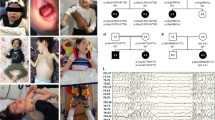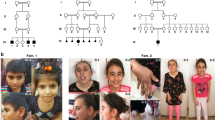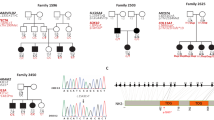Abstract
Non–syndromic, recessively inherited deafness is the most predominant form of severe inherited childhood deafness. Until now, no gene responsible for this type of deafness has been localized, due to extreme genetic heterogeneity and limited clinical differentiation. Linkage analyses using highly polymorphic microsatellite markers were performed on two consanguineous families from Tunisia affected by this form of deafness. The deafness was profound, fully penetrant and prelingual. A maximum two–point lod score of 9.88 (θ = 0.001) was found with a marker detecting a 13q locus (D13S175). Linkage was also observed to the pericentromeric 13q12 loci D13S115 and D13S143. These data map this neurosensory deafness gene to the same region of chromosome 13q as the gene for severe, childhood autosomal recessive muscular dystrophy.
This is a preview of subscription content, access via your institution
Access options
Subscribe to this journal
Receive 12 print issues and online access
$209.00 per year
only $17.42 per issue
Buy this article
- Purchase on Springer Link
- Instant access to full article PDF
Prices may be subject to local taxes which are calculated during checkout
Similar content being viewed by others
References
McKusick, V.A. Mendelian Inheritance in Man 10th edn (John Hopkins University Press, Baltimore, 1992).
Bergstrom, L., Hemenway, W.G. & Downs, M.P. A high risk registry to find congenital deafness. Otolaryngol. clin. N. Am. 4, 369–399 (1971).
Rose, S.P., Conneally, P.M. & Nance, W.E. Genetic analysis of childhood deafness. In Childhood deafness (ed. Bess, F.H.) 19–36 (Grune and Stratton, New York, 1977).
Fraser, G.R. The causes of profound deafness in childhood (John Hopkins University Press, Baltimore, 1976).
Paparella, M.M. Sensorineural hearing loss in children-genetic. In Otolaryngology Vol II, 2nd edn (eds Paparella, M.M, Shumrick, D.A.) (Saunders, Philadelphia, 1980).
Prezant, T.R. et al. Mitochondrial ribosomal RNA mutation associated with both antibiotic-induced and non-syndromic deafness. Nature Genet. 4, 289–294 (1993).
Hu, D.N., Qiu, W.Q. & Wu, B.T. Genetic aspects of antibiotic induced deafness: mitochodrial inheritance. J. med. Genet. 28, 79–83 (1991).
Baldwin, C.T., Hoth, C.F., Amos, J.A., da-Silva, E.O. & Milunsky, A. An exonic mutation in the HuP2 paired domain gene causes Waardenburg's syndrome. Nature 355, 637–638 (1992).
Tassabehji, M. et al. Waardenburg syndrome patients have mutations in the human homologue of the PAX-3 paired box gene. Nature 355, 635–636 (1992).
Hostikka, S.L. et al. Identification of a distinct type IV collagen a chain with restricted kidney distribution and assignment of its gene to the locus of X-chromosome-linked Alport syndrome. Proc. natn. Acad. Sci. U.S.A. 87, 1606–1610 (1990).
Meindl, A. et al. Norrie disease is caused by mutations in an extracellular protein resembling C-terminal globular domain of mucins. Nature Genet. 2, 139–143 (1992).
Legouis, R., Ayer-Le, Lievre., Leibovici, M., Lapointe, F. & Petit, C. Expression of the KAL gene in multiple neuronal sites during chicken development. Proc. natn. Acad. Sci. U.S.A. 90, 2461–2465 (1993).
Duyk, G., Gastier, J.M. & Mueller, R.F. Traces of her workings. Nature Genet. 2, 5–8 (1992).
Robinson, D., Lamont, M., Curtis, G., Shields, D.C. & Phelps, P. A family with X-linked deafness showing linkage to the proximal Xq region of the X chromosome. Hum. Genet. 90, 316–318 (1992).
Bach, I. et al. Microdeletions in patients with Gusher-associated, X-linked mixed deafness. Am. J. hum. Genet. 50, 38–44 (1992).
Leon, P.E. et al. The gene for an inherited form of deafness maps to chromosome 5q31. Proc. natn. Acad. Sci. U.S.A. 89, 5181–5184 (1992).
Reardon, W. Genetic deafness. J. med. Genet. 29, 521–526 (1992).
Ben Arab, S., Bonaiti-Pellié, C. & Belkahia, A. An epidemiological and genetic study of congenital profound deafness in Tunisia (governorate of Nabeul). J. med. Genet. 27, 29–33 (1990).
Weissenbach, J. et al. A second-generation linkage map of the human genome. Nature 359, 794–801 (1992).
Lathrop, G.M., Lalouel, J.M., Julier, C. & Ott, J. Multilocus linkage analysis in humans: Detection of linkage and estimation of recombination. Am. J. hum. Genet. 37, 482–498 (1985).
Hudson, T.J. et al. Isolation and chromosomal assignment of 100 highly informative human simple sequence repeat polymorphisms. Genomlcs 13, 622–629 (1992).
Petrukhin, K.E. et al. A microsatellite genetic linkage map of human chromosome 13. Genomics 15, 76–85 (1993).
Ben Othmane, K. et al. Linkage of Tunisian autosomal recessive Duchenne-like muscular dystrophy to the pericentromeric region of chromosome 13q. Nature Genet. 2, 315–317 (1992).
Azibi, K. et al. Severe childhood autosomal recessive muscular dystrophy with the deficiency of the 50 kDa dystrophin-associated glycoprotein maps to chromosome 13q12. Hum. molec. Genet. 2, 1423–1428 (1993).
Matsumura, K. et al. Deficiency of the 50K dystrophin-associated glycoprotein in severe childhood autosomal recessive muscular dystrophy. Nature 359, 320–322 (1992).
Ahn, A.H. & Kunkel, L.M. The structural and functional diversity of dystrophin. Nature Genet. 3, 283–291 (1993).
Byers, T.J., Lidov, H.G.W. & Kunkel, L.M. An alternative dystrophin transcript specific to peripheral nerve. Nature Genet. 4, 77–81 (1993).
Pillers D-A, M., et al. Dystrophin expression in the human retina is required for normal function as defined by electroretinography. Nature Genet. 4, 82–86 (1993).
Speer, M.C. et al. Confirmation of genetic heterogeneity in limb-girdle muscular dystrophy: Linkage of an autosomal dominant form to chromosome 5q. Am. J. hum. Genet. 50, 1211–1217 (1992).
Lyon, M.F. & Searle, A.G. Genetic variants and strains of the laboratory mouse (Oxford University Press, Oxford, 1989).
Hazan, J. et al. Autosomal dominant familial spastic paraplegia is genetically heterogenous and one locus maps to chromosome 14q. Nature Genet. 5, 163–167 (1993).
Conneally, P.M. et al. Report of the committee on methods of linkage analysis and reporting. Cytogenet. cell Genet. 40, 356–359 (1985).
Author information
Authors and Affiliations
Rights and permissions
About this article
Cite this article
Guilford, P., Arab, S., Blanchard, S. et al. A non–syndromic form of neurosensory, recessive deafness maps to the pericentromeric region of chromosome 13q. Nat Genet 6, 24–28 (1994). https://doi.org/10.1038/ng0194-24
Received:
Accepted:
Issue Date:
DOI: https://doi.org/10.1038/ng0194-24
This article is cited by
-
Genetics and meta-analysis of recessive non-syndromic hearing impairment and Usher syndrome in Maghreb population: lessons from the past, contemporary actualities and future challenges
Human Genetics (2022)
-
Identification of autosomal recessive nonsyndromic hearing impairment genes through the study of consanguineous and non-consanguineous families: past, present, and future
Human Genetics (2022)
-
Undescribed GJB2 c.35dupG homozygous prelingual distinguished from c.35delG homozygous/compound heterozygous deafs, dwelling a German ancestry Venezuelan isolate
Egyptian Journal of Medical Human Genetics (2021)
-
Characterization of GJB2 cis-regulatory elements in the DFNB1 locus
Human Genetics (2019)
-
Characterization of a novel MYO3A missense mutation associated with a dominant form of late onset hearing loss
Scientific Reports (2018)



